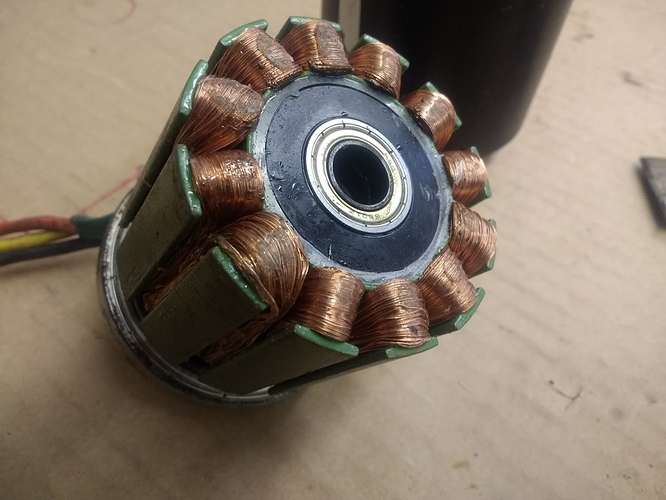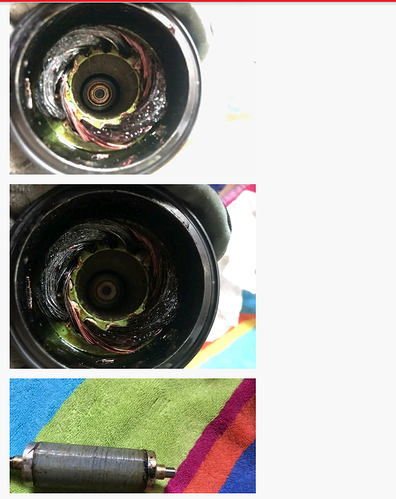Outrunners will always have more torque per weight and volume than inrunners.
The 80100 has around 15Nm maximum torque, according to 130Kv data 200A.
60s/min/(2pi130Kv)*200A=14,69Nm. Weighs 2kg.
The 6384 has around 7Nm, weighs 1kg.
Anyhow, i believe you can get some benefit over an outrunner if you have good sealings.
Is it somehow possible to expose the red mantle directly to the (sea) water to get better cooling and maybe less drag?
@Alexandre Good Point ![]()
@Toto44 It is 100KV: https://alienpowersystem.com/shop/brushless-motors/aps-56200-inrunner-brushless-motor-100kv-8000w/
15NM is a lot, can the 80100 draw 200A? Alien state in their 83110 160KV motors specs that it has 6.7NM of torque how do they come up with this figure?
When I use this calculator: Online calculator: Power into torque, and vice versa
I type in the max power of the motor: 48v x 130a = 6240W, and the max rpm: 48v x 130kv = 6240rpm - roughly 20% = 5100 rpm.
This leaves me with a torque of 11.7NM.
The max amps in aliens specs is 130A, so I guess the 56200 has a good chance, with a smaller prop.
I have a question about electric motors, I have been trying to get my head around this!
How can the 56200 motor have more power than the 56100 motor, when the wires are the same thickness, how can it handle more current? I understand that there is more wire, but it is the same thickness as in the shorter motor…
Im going to try and design it so that the red casing is directly exposed ![]()
I love this idea. Make the 3dprints match the housing of the motor! Excellent :)
The 83110 is watercooled inside the stator, so it has holes through the stator iron which hinders the magnetic flow and/or leaves less room for the windings. Therefore it has less power and torque than the 80100 i think.
The Kv = RPM/V and is a so called motor constant. So this specifies the speed. But it is linked to the Km , the unit is Nm/A. Kv=1/Km in the SI-system, so watch out for the units. Although this might not be perfectly true (where is the efficiency?) it is a good, safe and simple way to compare motors. Of course it is a good idea to check these values for plausibility by specified power, max RPM, max Current and Voltage.
This is strange indeed. Ask Bruno what it means. A motor with greater length (almost doubled i guess) should have lower Kv when using the same winding scheme, so it should take higher voltage, but not more current.
This is the inside of a 83110. The center is much larger than the 80100. The center is made from aluminum(Looks Black in the photo). It has about 3/16" holes in the aluminum that snake back and forth to provide a path for the water cooling. The 83110 has less room for copper but is very full of copper. The 80100 seems to have much more room for copper wire and appears to be less densely filed with copper wire. The bell on the 83110 is also 3mm bigger.
@PowerGlider I will ask Bruno, Ill let you know what he says.
@MAC thanks for the photo, clears things up. The windings on the 83110 water-cooled are very dense, the 80100 probably has slightly more copper still but they are much less filled.
That makes it a good candidate for sparse epoxying providing direct water cooling on the coils instead of indirect stator cooling which eats lots of space. And all this knowledge is hidden in an inrunner thread, what a mess.
Did you already get the 56200? I doubt it has power to go direct drive with mnm 130mm prop…?
I have already ordered it, whats the reason, not enough torque?
I bought the Watersports Hydrofoil dc Motor 70120 kv160 and tested it. Rotated at 7,000 rpms but it blew up a few minutes into water testing under load. Not sure if that was due to the lack of a thrust bearing or not.
Have you got any more pics of the setup it was used on?
Hi,
what propeller did you tried ? With 7000Rpm the diameter / pitch must be lower than in usual setups.
It was a high pitch torque design kinda like a regular outboard. Agreed it wasnt ideal and the likely reason for the failure. Just wanted to point out that cassie with the factory email and said it had a thrust bearing and after melting realized it doesnt.
I suggest gluing a thermistor (e.g. any 10k NTC with known beta value example NTC from mouser.com) to the motor winding head. I have had some in multiple locations. It is pretty easy with a Multimeter to watch the resistance during a test and abort testing if the resistance drops below a certain thresold. This threshold directly corresponds to a certain temperature. If you want a direct Temparature reading add a normal (non ntc) resistor and using for example the popular arduino boards to display the temperature directly. This is however not necessary if you only want to prevent the motor from overheating during tests. (A quick web search shows this example for arduino ntc temparure probe.)
Do you use the 83110 for efoil? Im thinking about trying one. Just not sure if it will handle the power…
The water cooling would make it possible to fully seal the motor and still keep it cool.
That is the motor I used last summer. But I made changes to it. I rewound it from its original 180KV to about, I think it was 116KV. I also made a different back for the motor out of aluminum. Most of what I did is in that thread For who try/have tried direct drive with outrunner
Jake,
Of all the problems I had, the motor burning up was not one of them. I did always have about a spoon full of mineral oil inside the dry pod. and unfortunately very often about a spoon full of lake water in the dry pod also. That may have helped with the cooling.


